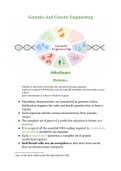Genetics And Genetic Engineering
Inheritance
We know…
- Genetics is the study of heredity and variation in living organisms
- A gene is a segment of DNA that controls a specific hereditary characteristic (e.g eye
colour)
- Each chromosome is a linear collection of genes
● Hereditary characteristics are transferred by gametes (when
fertilisation happens the male and female gametes fuse to form a
zygote)
● Each organism inherits certain characteristics from parents,
unique
● The complete set of genes of a particular organism is known as a
genome
● It is a copy of all the essential DNA coding required to synthesise
all proteins needed by an organism
● Each somatic cell 1possesses a complete set of genetic
instructions (genes)
● Red blood cells are an exception as they don't have nuclei,
thus no chromosomes and genes.
1
Any of the body cells except the reproductive cells.
,● All genes are found in all somatic cells, but, only certain genes are
activated in specific cells
● Genes are switched on by master/control genes
● Unique genes are determined by nitrogenous bases on DNA
molecules
● Scientists determine the evolutionary relationships between
organisms by studying the DNA sequences of different organisms
● 99.9% of humans DNA is identical
Gregor Mendel (1822-1884)
● Was an Austrian monk who studied and taught Natural Science
and Mathematics
● He performed experiments with pea plants in his free time to study
the inheritance of characteristics from one gene to another
● He was far ahead of the scientists of his time, but his work wasn't
acknowledged in the scientific community
● They valued his work after 20 years, after his death
● He is regarded as the “Father of Genetics”
Mendels Hereditary Experiments
● Mendel incidentally chose pea plants, but he didn't realise it
at the time as they show clear, observable contrasting
characteristics
● He studies 7 of these contrasting characteristics
- Tall and short
- Smoot seeds and w i k se
- Yellow and green seeds
- Inflated and constricted calls
- Green and yellow pods
- Purple and white flowers
- Axial and t e r m i n a t e d f l o w e r s
, ● These plants are self-pollinators, not cross-pollination
● He found this out as he cut off the anthers (containing
pollen) and conducting cross pollination himself
● Mendel then did this for pea plants that were
true-breeding2
Conclusions from emndels Experiments
● A hereditary characteristic is determined by two genes
● One gene is maternal, and the other gene is paternal, the gene pair
is carried on to chromazones of the homologous chromosome pair
● Jean occurs in two different forms that affect the characteristics in
different ways
● The alternative form of the same gene are known as alleles
● Different alleles contain different information about the same
characteristic
● For example, the plant length or colour as each gene has a specific
position on the chromosome this is called the locus
The alleles of a particular gene occur at the same locus on a
specific homologous chromosome pair
2
True breeding for a specific characteristic when self polination takes place and all
offspring produced will have the same characteristic of the parent
,- In the diagram above the alleles for genes occur at specific
locus on one homologous, chromosome pair, and the alleles
for another gene are at a different locus on another
homologous pair
- One allele of gene pair can mask another, this is known as
the dominant allele
- The allele that is masked, is called the recessive allele
- Mendels law of dominance: if two alleles are different, only
the dominant one will be expressed
, Genotype and Phenotype
The composition of gene pairs, meaning, two alleles, for a specific trait, is
known as the genotype
● An organisms genotype is represented by two letters, one being
CAPITAL in one being lowercase
● The CAPITAL is the dominant allele, and the lower case is the recessive
allele
● The dominant allele is always written first
- for example, pea plants have two alleles for plant length; Small and
tall
- Let’s say that tall is dominant over small
- The letter T is used for tall and the letter t is used for small
- A plant with the genotype TT has two alleles for tall, so it will
appear tall
- A plant with the genotype tt has two alleles for short, so it will
appear short
- A plant with the genotype of Tt has one allele for short, and one
allele for tall, given that tall is dominant over short, the tall traits
dominates, and the plant will be tall
the observable characteristics meaning the physical appearance of an
organism is determined by the genotype as well as the environments is
known as its phenotype,
For example, tall or short, yellow,or green seeds
, Homozygous and Heterozygous
An organism can be homozygous with respect to some traits and
homozygous in respect to other
Eg; a pea pla can be homozygous with respect to plant length (TT) and
heterozygous with respect to seed colour (Gg)
G=yellow
g=green
T=tall
t=tall
● When two alleles (gene pairs) are the same eg; TT or tt
Then the individual is homozygous for that specific trait
● When two alleles (gene pairs) are different eg; Tt
Then the individual is heterozygous for that specific trait
Homo - same
Hetero - different




